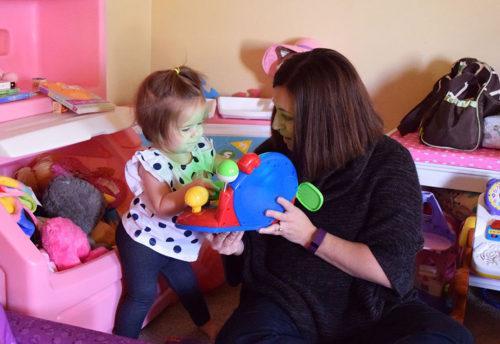
Tips for Talking to Families about Early Intervention
IN BRIEF:
• Early intervention is proven effective for improved long-term outcomes over a child’s lifespan.
• Early intervention is an evidence-based, family-implemented model of intervention for children birth to age 3 with a developmental delay or suspicion of a delay. It is offered at no cost to families.
• Pediatricians can play a key role in connecting families with EI services, especially by understanding some of the perceptions of families that may create barriers to accessing the services for which they qualify.
Introduction
Intervening early for a child with a developmental delay or suspicion of a delay is proven to positively impact the future outcomes for a child over his or her lifespan. Yet one of the challenges to intervening early is helping families move from eligibility to utilization of services that will help their child. Pediatricians play a critical role in these discussions and in helping families understand the positive impact of services available to them.
Despite evidence of effectiveness, research by the American Academy of Pediatrics (AAP) points out that fewer than 25% of children eligible for Early Intervention use these services. Usage is lower for African American and Hispanic children than white children. Additional new research from Groundwork Ohio shows that even in states like Ohio, where early intervention is serving families racially proportionate to the state’s population, there remains the question, how do we reach more of the families who qualify services but are not accessing them?
Some common “themes” or beliefs have been identified that may contribute to this disparity.
Understanding what EI is and its benefits as well as a family’s perceptions may help you navigate these conversations during check-ups and other visits.
What is Early Intervention?
EI is a program for children birth to age 3 that takes place in their home or other natural learning environment. It is a voluntary program for families that is offered at no cost. Referrals for services can come from anyone, including pediatricians and self-referral. Eligibility begins with an assessment in the home and an EI specialist assesses a child against milestones in five skill areas:
- Motor skills (fine and gross)
- Communication
- Self-help or adaptive
- Social and environmental
- Cognitive
Early intervention specialists focus on understanding the goals a family has for their child and figuring out how to best support the family and build capacity. Families are their child’s first and best teacher, and children learn best in the place most familiar to them with the people they love. EI specialists visit the young child’s natural learning environment in order to connect the child’s regular, everyday experiences to opportunities for interventions that will be delivered by the family. By understanding a household’s routines and interests, EI specialists can suggest tailored opportunities for families to make these every day routines and play incredible learning and growing experiences.
Early intervention looks different for every child and family because it is based on each family’s unique goals and the interests and strengths of their child.
Each U.S. state and territory has an agency that coordinates assessments and tailors EI services, at no cost to families. In Ohio, for example, Help Me Grow has this responsibility. See the chart below to find services in all states.
What Are the Benefits?
For the child, the first few years are a period of unparalleled development — as much as 90% of brain development happens by age 5. The earlier intervention starts, the greater the gains. EI can help eliminate or reduce the need for specialized services later in childhood and even into adulthood
Of course, a child is not an island. A child with a delay often changes the family ecology. EI boosts caregivers’ competence and confidence. By the time a child turns 3 (when EI services end), the family has the skills to advocate for their child’s ongoing developmental, educational, and medical needs.
Turning Perceived Barriers into Conversations
Common themes or perceptions of early intervention by families may be some of the cause for the disparity in the number of children who are eligible for early intervention and the number of families accessing the services. As a pediatrician, you are uniquely positioned to engage families and keep these perceptions from becoming barriers.
 Wait and See
Wait and See
Theme 1: “All children are different and will develop in their own time.”
Not surprisingly, mothers in the AAP study observed the development of their child and compared them to their other children, family members, neighbors and friends. If a family does not perceive that there is a delay, they are less likely to value or access EI services. Even when they do perceive a delay, some caregivers may not feel an urgency to act, thinking the child will “catch up.”
Opportunity: Rather than asking a family to evaluate their child’s potential deficits against a checklist, ask them reflective questions to begin a conversation about their child’s development. Showing them videos or pictures of children who are typically developing may help provide a framework that can better help them make an assessment of their child.
Likewise, helping a family understand the critical window of birth to age 3 may also encourage them to share their concerns and ask for an EI assessment. Chart the conversation to be able to bring it up at the next visit, especially if a different doctor at your clinic or practice will see the child: “I see we talked about EI at your last visit. Where are you with that?”
 Valuing Social Networks
Valuing Social Networks
Theme 2: “It’s not that I don’t trust the doctor…”
Relying on social networks is something most people do when seeking help and the study by AAP found a reliance on family, friends and other already-known people in making decisions about addressing possible delays.
Opportunity: Connecting families with others in their networks who have successfully used EI services may reinforce your message and offer them another avenue of support and information.
 Another Obligation
Another Obligation
Theme 3: “I have so much going on.”
Families have other obligations and lots of demand for their time. Families may already have contact with other support systems that impose their own requirements and accountability. Hearing about one more program, however well-intentioned, may not be welcome news or may feel like an overwhelming demand of their time.
Opportunity: Stress the flexibility of EI and the benefits to the entire family. Early intervention is made to work within the family’s schedules and activities as well as support the goals they have for their own family, not the other way around.
 Information Overload
Information Overload
Theme 4: Limited and conflicting information about EI, according to the AAP study, often results in delayed or foregone services.
Opportunity: Fortunately, easy-to-digest resources are available that appeal to a variety of learning and cultural styles while also offering solid information—short videos, phone apps, websites, and more (see the box below). The days of just handing a family a densely worded brochure are over.
In Summary
We know how time-pressed you are. When you, the trusted pediatrician, understand the goals and benefits of EI, it is easier to engage with families about the importance of intervening early which can help more children get access to the services they need sooner.
EI RESOURCES:
• • •
AAP Article and Research
Read the study and findings from the American Academy of Pediatricians about beliefs regarding developmental and early intervention among low-income African American and Hispanic mothers.
• • •
National Association for the Education of Young Children (NAEYC)
Full of research-based resources and tips for families including advice for good learning environments and standards for high-quality programs.
• • •
Intervening Early
The Meeples animated series offers an approachable look at the benefits of intervening early. See the difference early intervention can make over the lifespan of a Meeple or follow three different families through their adventures with early intervention. New this year is also a story of a Meeple family as they wrestle with the possibility of an autism diagnosis, as told from the perspective of the parents. The Meeple’s page also includes resources for both families and pediatricians.
CDC Milestones
See milestones for all ages – complete with pictures – as well as some warning signs that can help you know when it’s time to talk to your doctor. The CDC also offers a “Milestone Tracker” app you can download on your phone.
See milestones for all ages and check out the tracker app.
• • •
Zero to Three
Robust resources for families on a variety of topics for families with children who are zero to age three, including early development and well-being, early learning, parenting as well as policy and advocacy.
• • •
Find Early Intervention in Your State
Each state’s early intervention system is handled by a different agency. Use this resource for a complete list alphabetized by state.
OHIO SPECIFIC RESOURCES:
• • •
Groundwork Ohio Equity Report
A new report from Groundwork Ohio outlines the data for the state of Ohio for early childhood education.
Help Me Grow
Ohio’s Early Intervention System is called Help Me Grow. Your doctor or clinician can make a referral or you can refer yourself to get started with an assessment.
Action for Children
Resources for families including parenting workshops, kindergarten readiness and a free information and referral service to help you find the right child care provider for your child and family.





Leave a Reply